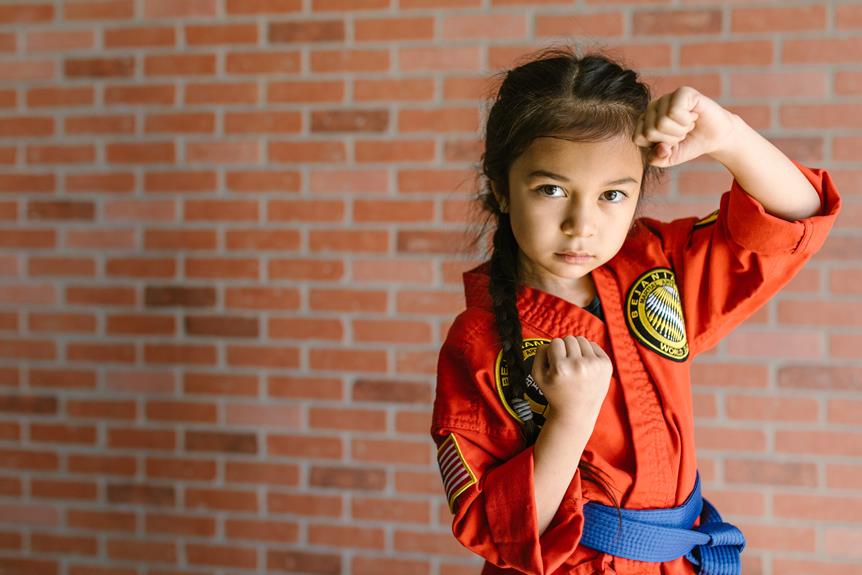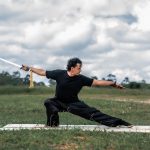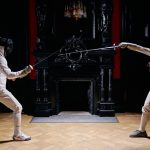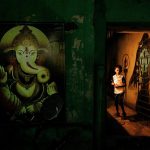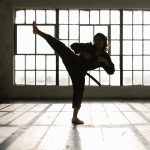Did you know that in the world of Muay Thai, fighters wear armbands called Pra Jiads?
These armbands, with a rich history dating back to the 16th century, are believed to bring good luck, protection, and support to the fighters during their bouts.
Not only do these Pra Jiads symbolize good luck, but they also hold a deep spiritual connection.
In this article, we will explore the cultural significance of these armbands and dispel any misconceptions related to ranking or training.
Key Takeaways
- Muay Thai fighters wear armbands known as Pra Jiads for good luck, protection, and support during fights.
- Pra Jiads have been a part of Muay Thai culture since the 16th century and symbolize good luck and safe return from war.
- Pra Jiads are commonly blessed by a Reusi or monk, making them sacred and connected to spiritual beliefs.
- There is no official armband ranking system in Thailand, but some schools in the West have introduced their own systems.
Significance of Pra Jiads
The significance of Pra Jiads in Muay Thai is deeply rooted in cultural symbolism and spiritual beliefs. These armbands hold immense importance for fighters, serving as talismans of good luck, protection, and support during their matches.
Pra Jiads have been an integral part of Muay Thai culture since the 16th century, representing not only good luck but also the desire for a safe return from war. These armbands are often blessed by a Reusi or monk, making them sacred and connected to spiritual beliefs.
The blessings can be personalized, with some fighters asking for specific strengths such as knockout power or speed. It is essential to note that Pra Jiads should never touch the ground or be stepped on, as this is considered bad luck and requires immediate replacement.
Historical Origins of Armbands
The armbands worn by Muay Thai fighters, known as Pra Jiads, have a rich historical background steeped in cultural symbolism and tradition. Here is a brief overview of their evolution:
- Origins in the 16th century: Armbands have been a part of Muay Thai culture since the 16th century, serving as symbols of good luck and safe return from war.
- Symbolic significance: Pra Jiads were believed to provide protection and bring good fortune to the fighters during battles.
- Connection to spiritual beliefs: These armbands were often blessed by a Reusi or monk, making them sacred objects infused with spiritual energy.
The historical origins of Muay Thai armbands highlight the deep-rooted cultural significance and spiritual beliefs associated with these talismans. They have evolved over the centuries to become an integral part of Muay Thai tradition, providing fighters with a sense of protection and support during their battles.
Blessing and Spiritual Connection
Muay Thai fighters have their armbands blessed by a Reusi or monk to establish a spiritual connection and imbue them with sacred energy. This blessing process is an important part of the cultural traditions surrounding Muay Thai.
The armbands, known as Pra Jiads, hold great significance for the fighters, as they believe that the blessing enhances their performance and offers protection during fights. The Reusi or monk conducts a ritual to infuse the armbands with positive energy and invoke the spirits for guidance and support.
This spiritual connection is deeply rooted in Thai culture and is believed to bring good luck and ensure the fighter's safety. The blessing process not only adds a sense of tradition and spirituality to the armbands but also serves as a reminder of the rich history and cultural heritage of Muay Thai.
Specific Strengths in Blessing
During the blessing process, Muay Thai fighters can request the Reusi or monk to bestow specific strengths upon their Pra Jiads. This practice is deeply rooted in cultural beliefs and adds a personalized touch to the armbands.
Here are three examples of specific strengths that fighters may seek during the blessing:
- Increased Knockout Power: Fighters may ask for the blessing to enhance their knockout power, believing it will give them an advantage in the ring.
- Enhanced Speed and Agility: Some fighters may request specific strengths related to speed and agility, aiming to outmaneuver their opponents with quick strikes and footwork.
- Improved Mental Focus: Mental strength is crucial in Muay Thai, and fighters may seek a blessing for improved concentration and focus during their fights.
Superstitions and Taboos
Continuing from the previous subtopic, the superstitions and taboos surrounding Muay Thai armbands, known as Pra Jiads, play a significant role in the fighters' beliefs and practices.
These superstitions reflect the deeply ingrained cultural and spiritual significance of the armbands in Muay Thai. One common superstition is that the Pra Jiads should never touch the ground or be stepped on, as it is believed to bring bad luck. If this happens, the armband is immediately replaced.
Additionally, some fighters believe that wearing the Pra Jiad upside down or inside out is taboo, as it signifies a reversal of luck and protection. These superstitions highlight the reverence and respect that fighters have for their armbands, reinforcing the talismanic power they hold in the realm of Muay Thai.
Optional Nature of Pra Jiads
The wearing of Pra Jiads by Muay Thai fighters is optional, as it is not mandatory for every fighter to wear them during fights. Here are some key points to understand the optional nature of Pra Jiads:
- Foreign fighters: Muay Thai fighters from outside of Thailand may choose not to wear Pra Jiads because these armbands do not hold the same cultural significance for them. They may not have the same beliefs or traditions associated with the armbands.
- Cultural significance: While Pra Jiads hold deep cultural significance in Thai Muay Thai, not all fighters feel the need to wear them. Some fighters may have their own personal rituals or beliefs that they rely on for luck and protection during fights.
- Personal preference: The decision to wear a Pra Jiad is often a personal one. Some fighters may choose to wear them for their own reasons, such as tradition, personal beliefs, or as a way to honor the culture of Muay Thai.
Armbands in Foreign Competitions
In foreign Muay Thai competitions, fighters from outside of Thailand may choose not to wear Pra Jiads, as these armbands do not hold the same cultural significance for them. Muay Thai is deeply rooted in Thai culture, and the wearing of Pra Jiads is a tradition that has been passed down for centuries.
However, cultural differences and personal preferences play a role in the decision of foreign fighters to forgo wearing armbands. While some may choose to embrace the tradition and wear Pra Jiads as a sign of respect for the sport and its origins, others may not feel the same connection and opt to compete without them.
It is important to understand and respect these cultural differences when participating in international competitions, as they contribute to the diverse nature of the sport.
Placement and Personal Preference
Transitioning from the previous subtopic, the placement and personal preference of Muay Thai fighters in wearing armbands (Pra Jiads) during fights is a matter that varies among individuals.
Here are some key points to consider regarding Pra Jiad placement and individual preferences:
- Placement:
- Armbands are typically worn just above the bicep, below the shoulder.
- This placement allows for freedom of movement and ensures that the armbands do not interfere with the fighter's technique.
- The exact positioning may vary slightly based on personal preference and comfort.
- Individual Preferences:
- Some fighters choose to wear two armbands, while others prefer to wear only one.
- The decision to wear multiple armbands is purely a personal choice and does not hold any specific significance.
- The choice of material for the Pra Jiad, such as cotton, cloth, nylon, or hemp rope, also varies according to personal preference.
Materials Used for Pra Jiads
Pra Jiads are commonly made from cotton, cloth, nylon, hemp rope, or a combination of these materials. Originally, Pra Jiads were made from cotton sarongs worn around the waist. However, nowadays, fighters have more options in terms of materials. Nylon or hemp rope Pra Jiads are more common as they can be conveniently bulk ordered from manufacturers. This has led to a decrease in the prevalence of gym-made Pra Jiads.
The material of the Pra Jiad itself does not hold any specific significance or ranking. Instead, the focus lies on the cultural and spiritual meaning behind the armband. Muay Thai fighters wear Pra Jiads as talismans of protection and good luck, regardless of the material used.
Frequently Asked Questions
Are There Any Specific Rules or Rituals Associated With Wearing Pra Jiads During a Muay Thai Fight?
There are no specific rules or rituals associated with wearing Muay Thai armbands (Pra Jiads) during a fight. However, some fighters choose to wear two armbands, but it is a personal preference without any significant meaning.
What Is the Significance of Wearing Two Pra Jiads Instead of Just One?
The significance of wearing two Pra Jiads in Muay Thai is not rooted in historical origin or cultural traditions. It is purely a personal preference without any specific meaning or significance in the sport.
Do Different Colors or Designs of Pra Jiads Hold Any Specific Meaning or Symbolism?
Different colors and designs of pra jiads in Muay Thai do not hold specific meanings or symbolism. The cultural significance of pra jiads lies in their history as talismans of good luck, protection, and support during fights.
Are There Any Famous or Legendary Fighters Known for Their Use of Pra Jiads?
Famous fighters like Buakaw Banchamek and Saenchai have been known to wear pra jiads, showcasing their reverence for tradition and their belief in the talisman's power. The historical origins of pra jiads date back to the 16th century, symbolizing good luck and protection.
Are There Any Traditional Ceremonies or Events Where Pra Jiads Are Prominently Featured or Celebrated?
Traditional ceremonies involving pra jiads are often held before important Muay Thai fights, where the armbands are blessed by a Reusi or monk. The process emphasizes their spiritual significance and connection to the fighter's beliefs, adding to their cultural value.
Conclusion
In conclusion, the wearing of armbands, known as Pra Jiads, by Muay Thai fighters holds deep cultural and spiritual significance. These talismans are believed to bring good luck, protection, and support during bouts.
With a history dating back to the 16th century, Pra Jiads symbolize not only luck but also a safe return from war. While not mandatory, many fighters choose to wear them, demonstrating their belief in their power.
It is important to respect the sacredness of Pra Jiads and understand their cultural importance in the world of Muay Thai.
- 15 Best Martial Arts Weapons (Fighting & Training) - October 14, 2024
- Is Fencing a Martial Art? (Yes, 4 Reasons Why) - October 14, 2024
- 7 Best Martial Arts for Self-defense Ranked (Highly Effective) - October 14, 2024
